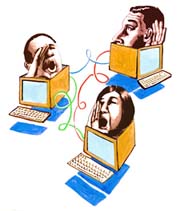Avi Blizovsky

The movie Matrix brings to extremes the possibility of a computer creating a world and giving those in it a feeling as if it were the real world. In reality, the situation may not be so extreme, but technology is advancing in the direction of allowing illusions and not just optical ones.
Dr. Doron Friedman's book Virtual Environments was recently published by Gali IDF Broadcasting University Press and the Ministry of Defense Publishing House. Friedman is a researcher at the Virtual Reality Lab at UCL University in London. His research deals with the relationship between advanced media environments, and in particular virtual reality, and the human brain. In addition to this, he deals with various applications of artificial intelligence both in academic research and for the needs of industry.
It turns out that this vision of virtual reality, which has existed since the XNUMXs, needs to be updated in the Internet age. In chapter XNUMX of the book, or actually in the eighth lecture in the series at the Galz, he says that the vision of artificial intelligence from the early period spoke only of the physical world. According to this vision, in the future our lives will be intertwined with those of physical robots, more or less intelligent. It seems that the time has come to update this vision, and to recognize that a large part of our lives we spend not only in the physical world but also in a virtual or semi-virtual world, mediated by the media. This world will be populated not necessarily by physical robots but by intelligent virtual characters.
Later in the chapter Friedman describes uses for assembling virtual elements on top of an image that reflects reality. Military applications of this type are already being used by pilots. The research today deals with the application of augmented reality to ground soldiers as well, let's say such a soldier wears a helmet, or in the future special glasses, so that he sees the battlefield with helpful markings on it. For example, he can see the exact distance from various objects displayed numerically, or even see markings on enemy units hiding, assuming that they watched from another position and their location was entered into the system and transmitted to him via wireless communication.
In the medical field, it is possible to receive data obtained from imaging devices and display them visually on the patient's body or on a picture of the patient. During the planning of the surgery, or maybe even during the surgery itself, the doctor can see these data and other data, in addition to the fact that he sees the patient through his eyes as usual. Supposedly the doctor has the ability to take X-rays. Similarly, instead of carrying instruction books, aircraft technicians can see the diagrams drawn on the surface of the device they need to check or repair right while working. It turns out that the printed technical specifications of the Boeing 777 are heavier than the plane itself. In a similar way, you can think of applications to help with navigation, imagine that you see written information detailing what is in each building in an area of office buildings in a large city, or imagine that you are walking in the remains of an ancient city, but see the destroyed parts restored and presented as virtual information. Several universities in the UK are involved in a project that allows, among other things, to display virtual information on radiation levels, pollution levels, geological mapping, underground pipes - all this while moving around in the real world, relying on a combination of precise location tracking and existing maps. The interface does not have to be wearable like helmets, but can also be a handheld computer.
In the field of sports, we know, for example, a method of putting advertisements in the stadium virtually, so that there will be different advertisements on different channels broadcasting the same game (for example, in Hebrew for viewers in Israel and in Russian for viewers in Russia in the soccer match between the two national teams).
Most of the chapters obviously deal with a single viewer entering a world that is entirely computerized, but one of the chapters also deals with theories and the first practical solutions for developing virtual communities. And also about the difference between a movie and virtual reality - in a movie you can make a "cut" and go to the next scene. In virtual reality, the user identifies himself with the location of the camera and not as a bystander, therefore such a "cut" means a jump in space (teleportation in the XNUMXth).
In short, a book that combines theories and reality and maybe reality and imagination, to get a (real?) picture of the virtual world.
https://www.hayadan.org.il/BuildaGate4/general2/data_card.php?Cat=~~~600697829~~~80&SiteName=hayadan
